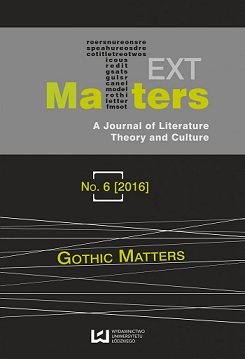Transgression of Postindustrial Dissonance and Excess: (Re)valuation of Gothicism in Jim Jarmusch’s Only Lovers Left Alive
DOI:
https://doi.org/10.1515/texmat-2016-0013Abstract
The paper gives insight into the revaluation of popular Gothic aesthetics in Jim Jarmusch’s 2014 production Only Lovers Left Alive. Drawing on critical theory and the postmodern theoretical framework, the article suggests that the film transgresses contemporary culture immersed in a “culture of death” that has produced a vast amount of cultural texts under the rubric of “Gothicism.” By considering Jean Baudrillard’s concept of transaesthetics and Judith Halberstam’s writings on contemporary monstrosity, the paper shows that a commodified Gothic mode has lost its older deconstructive functions that operated on the margins of the mainstream. Now entirely focused on the duplication of the same aesthetic codes and signs, Gothic productions conform to the rules of postindustrial culture, enriching entertainment imagery with the neutralized concept of “otherness.” Hence, the article engages primarily with Jarmusch’s indie aesthetics that goes beyond easily recognizable patterns and generic conventions and allows the director to emphasize that the arts are rejuvenating forces, the antidote to a commoditized environment. Then, the focus is on the construction of main characters—Adam and Eve, ageless vampires and spouses—who thanks to nostalgic theatricality and performance reconfigure the mainstream monstrosity. Ultimately, the article emphasizes that Jarmusch’s film, to a large extent, becomes a warning against the inevitable results of advanced capitalism practiced on a global scale.
Downloads
References
Baudrillard, Jean. “Symbolic Exchange and Death.” Selected Writings. Oxford: Blackwell, 2004. 119–48. Print.
Google Scholar
Botting, Fred. Gothic. London: Routledge, 2005. Print.
Google Scholar
Braidotti, Rosi. Nomadic Theory. The Portable Rosi Braidotti. New York: Columbia UP, 2011. Print.
Google Scholar
Deleuze, Gilles, and Felix Guattari. A Thousand Plateaus. Capitalism and Schizophrenia. Trans. Brian Massumi. Minneapolis: U of Minnesota P, 1987. Print.
Google Scholar
Featherstone, Mike. Consumer Culture and Postmodernism. London: Sage, 2007. Print.
Google Scholar
Green, Richard, and K. Silem Mohammad. Zombies, Vampires and Philosophy. New Life for the Undead. Chicago and La Salle, IL: Open Court, 2010. Print.
Google Scholar
Grossman, Lev. “Zombies Are the New Vampires.” Time (online), 9 Apr. 2009. Web. 23 Nov. 2012.
Google Scholar
Halberstam, Judith J. Skin Shows: Gothic Horror and the Technology of Monsters. Durham, NC: Duke UP, 1995. Print.
Google Scholar
Hogle, Jerrold, E. The Cambridge Companion to Gothic Fiction. Cambridge: Cambridge UP, 2002. Print.
Google Scholar
Hutcheon, Linda. “Irony, Nostalgia and the Postmodern.” UTEL. 19 Jan. 1998. Web. 13 Sept. 2012.
Google Scholar
Kellner, Douglas. Baudrillard: A Critical Reader. Oxford: Blackwell, 1995. Print.
Google Scholar
Miles, Robert. Gothic Writing 1750–1820: A Genealogy. London: Routledge, 1993. Print.
Google Scholar
Only Lovers Left Alive. Dir. Jim Jarmusch. Perf. Tilda Swinton, Tom Hiddleston, Mia Wasikowska. Recorded Picture Company, 2013. Film.
Google Scholar
Suarez, Juan A. Jim Jarmusch (Contemporary Film Directors). Urbana: U of Illinois P, 2007. Print.
Google Scholar
Tenga, Angela, and Elizabeth Zimmerman. “Vampire Gentlemen and Zombie Beasts: A Rendering of True Monstrosity.” Gothic Studies 15.1 (2013). Academia.edu. Web. 20 Sept. 2014.
Google Scholar
Downloads
Published
How to Cite
Issue
Section
License

This work is licensed under a Creative Commons Attribution-NonCommercial-NoDerivatives 4.0 International License.













